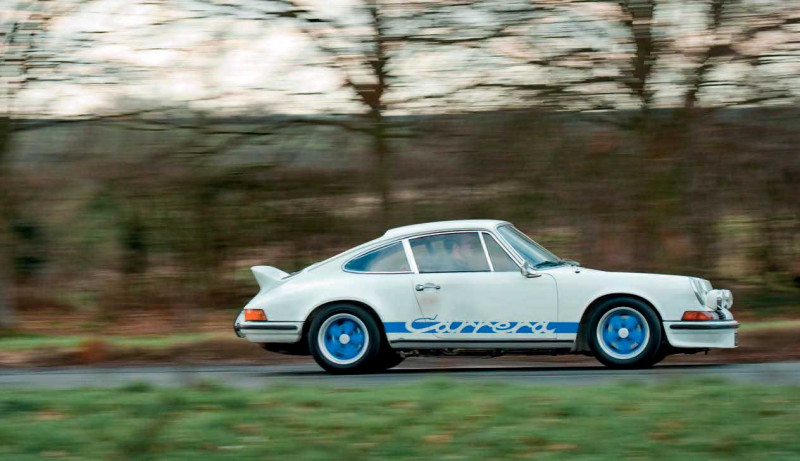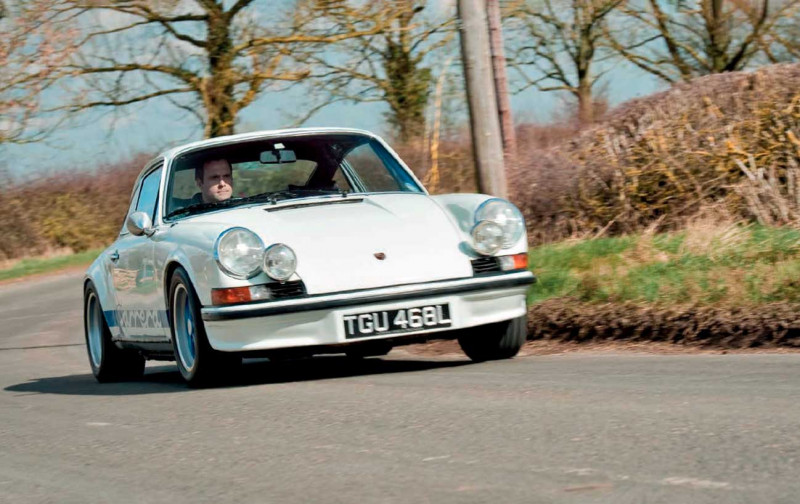The 1973 Porsche 911 Carrera RS 2.7’s ducktail may have become a style icon
The Carrera RS 2.7’s ducktail may have become a style icon, but it was the start of Porsche’s focus on aerodynamics for both its race and road cars. Fifty years on, it’s also a feature of the manufacturer’s very latest products...
Words Shane O’Donoghue
Photography Dan Sherwood, Porsche
SPOILER ALERT
The RS ducktail and its lasting legacy.

The Carrera RS 2.7’s ducktail is nothing short of an iconic piece of automotive design. Porsche unashamedly uses the feature as a retro flourish for its modern Sport Classic models, including the 997 and the very latest 992 of the same name. And, as described by Karl Ludvigsen on the previous pages, while Anatole Lapine styled the production version of the RS’s ducktail, it was initially conceived as a functional add-on to reduce high-speed lift at the back of the 911.
PORSCHE TOOK THE OPPORTUNITY TO REALLY PUSH THE BOAT OUT FOR THIS SPECIAL 911

Remarkably, little work had been done by Porsche in the field of aerodynamics until this point, other than occasional attempts to reduce drag. This is one of the easiest measurements to comprehend in aerodynamics. In short, as a vehicle travels through the air, it exerts a drag force on it in the opposite direction. It’s not difficult to understand how an articulated truck, for example, will experience more drag at a given speed than, say, a 356 coupe. Drag is largely determined by the frontal area of a car, but it is also proportional to the speed squared. At higher speeds, the engine has to work much harder to overcome this force. Hence, anything that can be done to reduce drag helps with performance and, of course, assists fuel economy.
Ferdinand Porsche understood this well before the company bearing his name existed, as evidenced by the streamlined designs of the 1933 NSU Type 32 and the Volkswagen Beetle. This expertise carried through to the 356 and 550 Spyder, designed by Porsche’s body expert and aerodynamicist, Erwin Komenda. The initial 911 (Type 901) continued the theme, with its remarkably small frontal area.
Nonetheless, with increasing performance and higher speeds, a downside of the 911’s shape was soon discovered — its propensity for lift. This is the opposite of downforce insofar as it exerts an upwards force on the car body. Even small amounts of lift are undesirable, altering a car’s weight distribution and grip levels by reducing contact pressure on the tyres, leading to instability. Conversely, downforce — or negative lift — adds weight, pushing the car down, which aids stability and can increase cornering speeds.
To understand all this, it’s easiest to imagine two pathways for air to flow as a car travels through it. Some of the air goes over the car, some of it goes under. Obviously, air goes around the car, too, but that’s of less interest to our explanation. The air going over the top has, simplistically speaking, further to travel in the same amount of time than the air moving in almost a straight line under the car. This causes the air going over the top of a car to speed up. According to Bernoulli’s principle (one of the most important in fluid dynamics), for a given volume of air, the higher the speed the air is travelling, the lower the pressure. Likewise, the lower the speed of the air, the higher the pressure. Hence, the slower air underneath a car is at higher pressure, while the faster air over the top is at lower pressure.
BORN SLIPPY
This has the effect of pushing the car up. Therefore, all things being equal, a slippery car body with a small frontal area will mean increased speed of air over the car and, while this reduces drag, it can also increase lift. This is a simplification — various bits of a car, such as the windscreen and wheel wells, can contribute high- or low-pressure pockets of their own, but the fact is all Porsches produced up to the early 1970s exhibit net lift at higher speeds.
The same could be said for Porsche’s racers. Even with the massive budget which made the 917 possible, there was limited understanding of the car’s aerodynamics and how they were responsible for the early 917’s wayward handling. The fix came about at a test session in 1970, where sheets of aluminium were quite literally taped and riveted onto the back of the car until it drove as expected. Even so, the reasons this worked were not fully understood.
As mentioned by Ludvigsen, the first implemented solution for Porsche’s road cars came in the form of a relatively subtle-looking airdam developed in a wind tunnel. An airdam, as the name suggests, is when the lower front bodywork forms a dam for the airflow. Naturally, it can’t ever extend all the way to the ground and all the way around the side to touch the tyres, but it does manage to cause an air restriction, which both speeds up the air under the car and results in a ‘sheltered’ section directly behind the airdam. Both of these are of low pressure, meaning a reduction in lift at the nose of the car. Such a device was fitted to the 1972 911 S, reducing lift by forty-four percent with no additional drag. The Carrera 2.7’s ducktail followed on from this, and though the design of this type of spoiler was led by the trial and error of physical testing (as opposed to computational fluid dynamics on today’s powerful computers), it was clear Porsche had truly started down a path of understanding automotive aerodynamics and how to optimise them to its needs.
Much of Porsche’s early wind tunnel work was conducted under the management of motorsport engineer, Norbert Singer, with a view to improving the 911’s performance as a racer. Indeed, hot on the heels of the road-going Carrera RS 2.7 came the 1974 911 Carrera RSR Turbo 2.1, complete with its outrageously large rear wing. Note that we’re using the word ‘wing’ here, not spoiler.
Pioneered by the aeronautical industry, the profile of a wing takes advantage of the Bernoulli principle described above, where higher air velocity means lower pressure, and vice versa. The upper surface of an aeroplane’s wing is longer than the bottom’s, meaning the air has further to travel. Therefore, it speeds up, reducing the pressure. The opposite happens at the bottom surface of the wing, resulting in a net force up on the wing (i.e. the aircraft files). Now, turn the wing upside down and bolt it to a car. Hey presto! The air pressure differential between the top and bottom surfaces pushes the car down onto the road or track. The 911 racer didn’t just feature a ducktail-like bustle on the rear, but a full-on wing with endplates. Those endplates stop ‘leakage’ of the high-pressure air to the low-pressure side around the periphery of the wing, maximising its effectiveness. Wings have been found to be far more efficient, in terms of reducing lift, than spoilers, because they create less drag.
An evolution of the blueprint laid down by the Carrera RS 2.7 was the Carrera RS 3.0. The FIA’s homologation rules had changed, meaning Porsche didn’t need to manufacture as many vehicles to qualify the car for racing — where the Carrera RS 2.7 had to be a realistic road car due to the relatively high number of examples Porsche was required to manufacture, only one hundred versions of the Carrera RS 3.0 were required. Consequently, the company took the opportunity to really push the boat out for this special 911. It was deemed acceptable for these cars to be more extreme.
Though the 911 Turbo (930) which followed is probably the Porsche most associated with the new whale-tail-style rear spoiler, the Carrera RS 3.0 is the 911 which featured it first, evolving lessons learned in the creation of the ducktail and racing 911 to further reduce lift. The massive increase in dimensions was with motorsport in mind, allowing Porsche to run large wings on its 911 racers. Indeed, examples of the Carrera RS 3.0 sold in Germany came with two different spoilers — a smaller, road-legal version fitted at the factory and the larger spoiler synonymous with 911s of the era.
THROUGH THE RANKS
The Carrera RS 3.0’s deep front airdam and large whale tail appeared on the 930 prototype revealed at the 1973 Frankfurt Motor Show and was carried through to the production version of the turbocharged 911. Porsche also fitted the rear spoiler as standard to its Carrera models from 1975, while its race cars, such as the 934 and 935, featured more complex and much larger appendages optimised for high-speed track driving. Armed with its relatively newfound knowledge of automotive aerodynamics, Porsche looked to return a purer silhouette to the 911 for the arrival of the 964 in 1989. The solution was an electrically extending rear spoiler. Up to 50mph, the spoiler — equipped with an integrated air grille — was more or less flush with the rear engine cover. Above this speed, an electric motor moved the spoiler up into place, contributing to a claimed zero lift scenario at high speed. Porsche says the system didn’t increase drag, either.
This wasn’t the only aerodynamic innovation of the 964, which featured smooth underbody panels, a bonded-in windscreen and rain gutters designed for minimal interruption of the airflow, again to reduce drag. The chunky new front bumper design of the 964 caused the airdam effect described above and, where the 1972 911’s side sills allowed the fast-moving air to escape, the 964 featured lower sills in a bid to trap air and enhance the effect. The result was low lift at the front, as well as at the back, and an impressively low coefficient of drag. This approach was carried forward to the last of the air-cooled 911s, the 993, with further focus on reducing drag through a smoother design. Indeed, the 993 was informed by the significant development work Porsche expended on the 959, though it didn’t receive the 959’s ride height reducing dampers or its full-width rear wing. Looking back at the angled piece of plastic atop the rear of the Carrera RS 2.7, it’s funny to think this small part has become as legendary as an iconic sports car, such as the 959. One thing’s for sure: the RS ducktail was certainly a ‘Eureka!’ moment for Porsche and, while the brand’s current cars make use of modern advanced aerodynamics, the introduction of a ducktail on the 992 Sport Classic proves our favourite manufacturer can’t quite let go of the little spoiler which started it all.
Below A 2.4-litre 911 steps in to assist with first attempts to model the Carrera RS 2.7’s ducktail spoiler. Above The final ducktail has gone down in automotive history as a design icon and continues to influence Porsche production Top right An early example of the ducktail in place Below Ducktail development at Weissach 1973, where the body shell of the 917/30 Spyder and Carrera RS 2.7 are being worked on in front of a stack of new RS engine lids. Below Cd value determination for the Carrera RS 2.7, featuring wind tunnel testing of the model with and without its now iconic ducktail.

